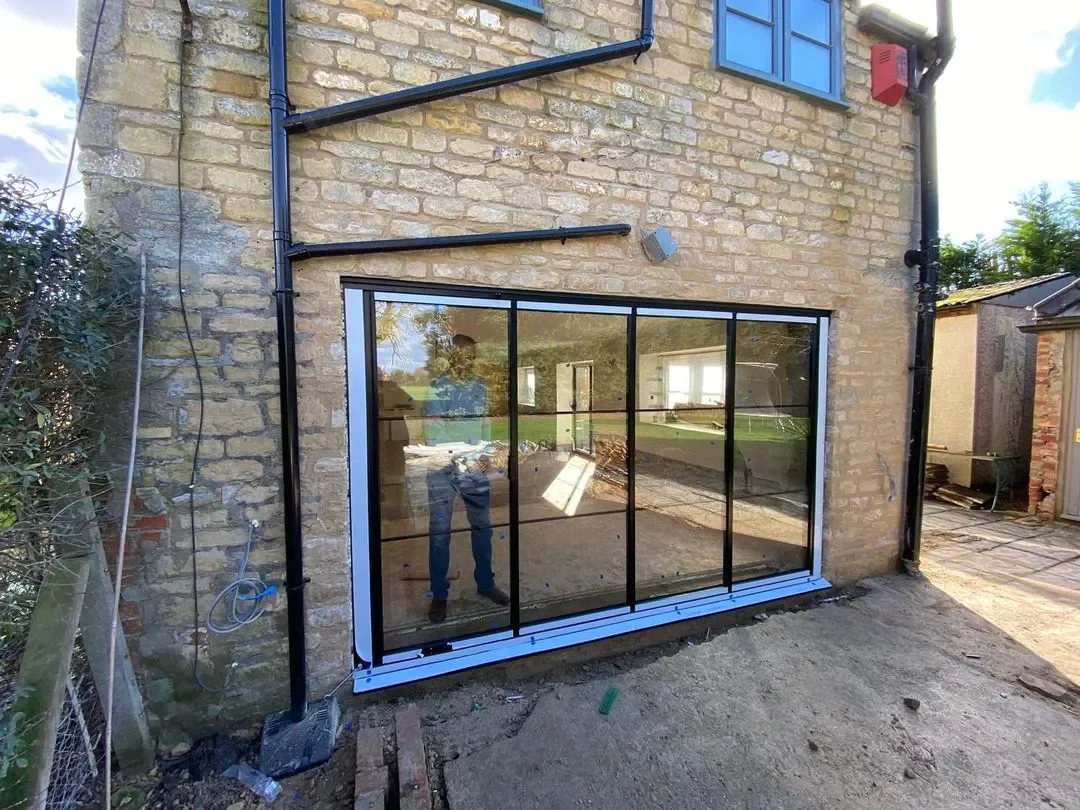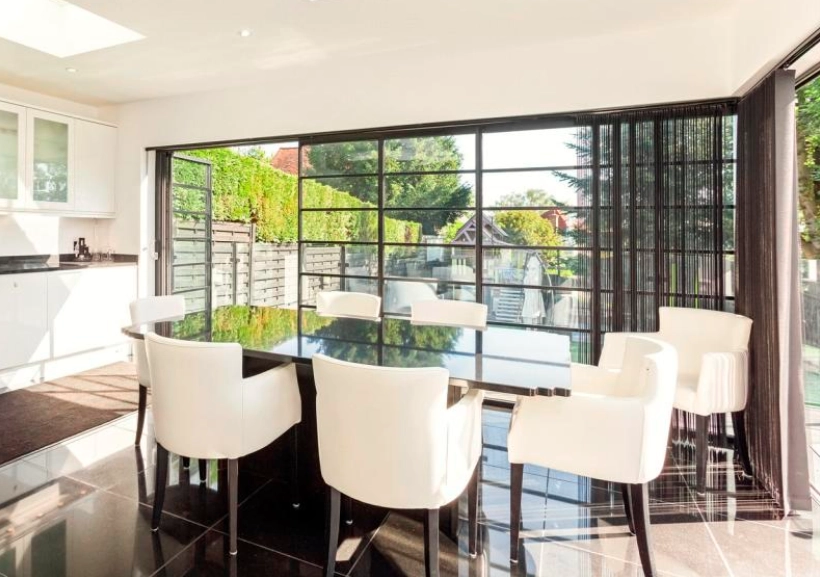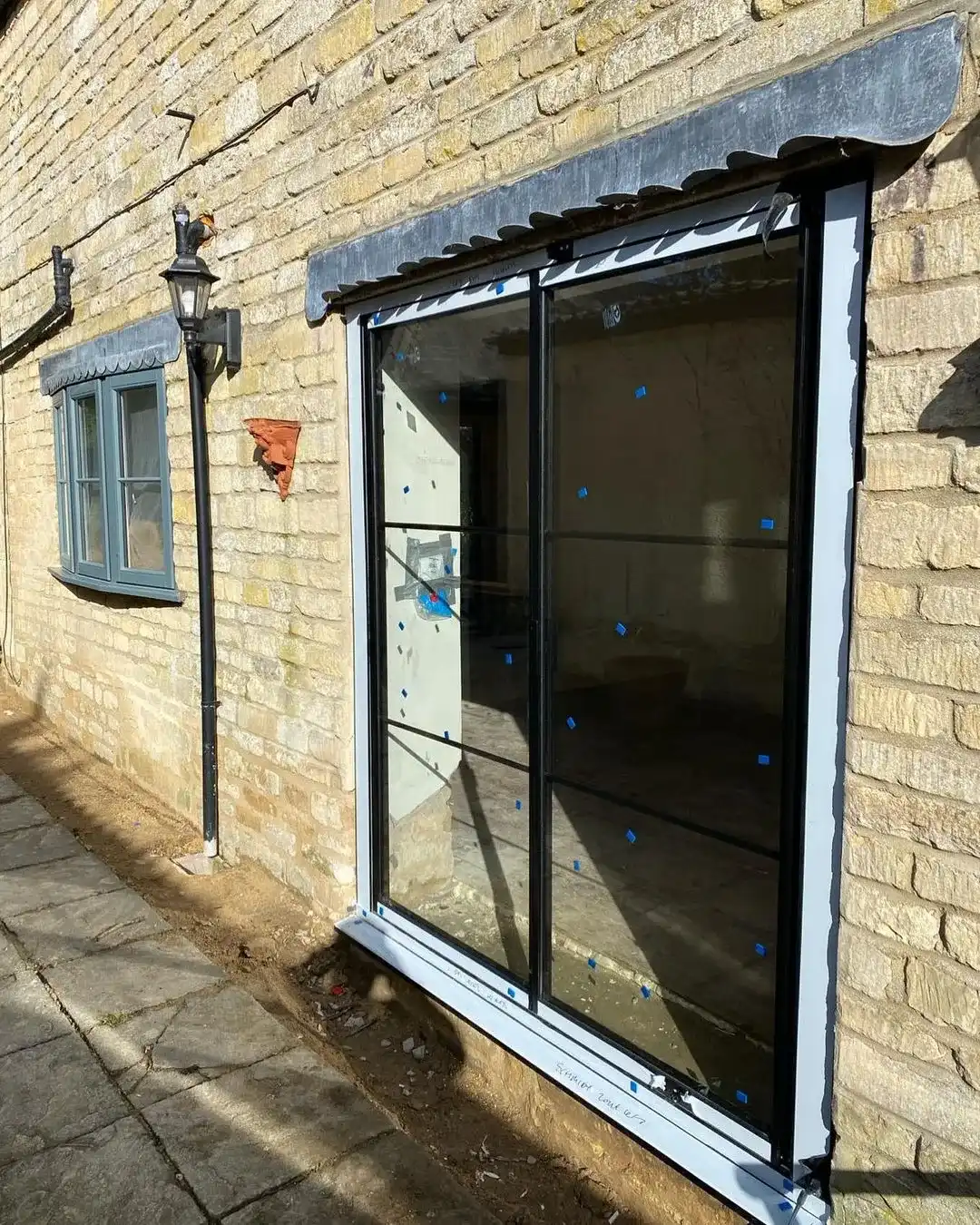Industrial Style Patio Doors: Materials, Design & Styling Guide
Table of Contents

The Rise of Industrial Style Patio Doors
The striking appearance of industrial style patio doors stems from their practical origins in Britain’s manufacturing past. These distinctive doors first appeared in factories and warehouses during the Industrial Revolution, where their robust steel frames and generous glazing brought natural light to vast workspaces.
Factory to Home
Steel-framed doors began their journey in the manufacturing sector, where unlike traditional steel doors of the time, they combined strength with large glass panels. The marriage of metal and glass proved so practical that architects soon spotted their potential for residential buildings. By the 1920s, forward-thinking homeowners started incorporating these industrial elements into their properties, drawn to their bold lines and ability to flood rooms with daylight.

Industrial Legacy
Metal windows from the late 19th century shaped the look we now associate with industrial style patio doors. Their distinctive approach to manufacturing featured slim steel frames divided into geometric patterns, creating a striking grid effect that became synonymous with factory architecture. Modern interpretations still mirror these original designs, though today’s doors use advanced materials that perform better than their historical counterparts.
Today’s Urban Revival
The renewed interest in industrial style patio doors gained momentum as developers began converting old warehouses into living spaces. Black framed doors with metal glazing bars became a hallmark of urban regeneration projects, preserving the raw character of industrial buildings while meeting modern comfort standards. The style soon spread beyond converted properties, as homeowners recognised how these doors could add architectural interest to contemporary builds and period properties alike.
Design Evolution
Modern industrial style sliding doors maintain the original aesthetic while incorporating technical improvements. Thermal breaks, multi-point locking systems, and double glazing bring practical benefits without compromising the authentic look. Manufacturers now offer these doors in various configurations, from sliding systems to bi-folding options, all featuring the characteristic grid patterns and slim sightlines that define industrial styling.
Industrial Style Patio Door Types
Modern industrial style patio doors come in several distinct variations, each offering specific benefits for different architectural contexts. Steel remains the traditional choice for authentic period properties, while aluminium provides a cost-effective alternative that maintains the characteristic slim aesthetic.
Steel Frame Doors
Traditional steel-framed industrial style patio doors stand out for their extraordinary strength-to-weight ratio. The robust nature of steel allows for remarkably slim frames without sacrificing structural integrity. These heritage-style doors feature precision-welded joints and thermally broken profiles that prevent cold spots around the frame. Powder-coated finishes in dark greys and blacks protect the metal while maintaining the raw industrial look that made these doors popular in the first place.
Manufacturing steel doors requires specialist expertise, particularly in creating the sharp corners and clean lines that define industrial styling. The metalwork must be exact, as even minor imperfections become obvious in such minimal designs. High-quality steel frames incorporate subtle design elements like exposed fixings and mechanical joints that add authentic detail while serving practical purposes.

Steel vs Aluminium
Large aluminium sliding doors have become increasingly common in modern interpretations of industrial style. Advanced extrusion techniques produce profiles that closely match the dimensions of traditional steel, creating a similar visual impact at a lower price point.
Modern powder coating processes replicate the textured finish of old factory windows, making these aluminium versions hard to distinguish from their steel counterparts.
The lighter weight of aluminium makes it particularly suitable for sliding configurations of industrial style patio doors.
Runners and bearings last longer due to reduced stress, and the doors themselves need less force to operate. Premium systems use multi-point locking mechanisms concealed within the frame, preserving clean lines while meeting current security standards.
Hybrid Systems
Some manufacturers combine materials to create industrial-style doors that harness the benefits of different metals. Aluminium outer frames paired with steel glazing bars deliver authentic aesthetics and improved thermal performance. These hybrid approaches often incorporate warm edge spacer bars and argon-filled glass units, resulting in excellent heat retention without compromising the characteristic industrial appearance.
Glass Division Patterns
The arrangement of glazing bars defines the character of industrial style patio doors. Traditional configurations feature equal-sized panes arranged in grid patterns, though modern interpretations sometimes play with asymmetrical layouts. Glazing bars can be real or astragal bars applied to the surface of larger glass units – each method produces slightly different shadow lines and reflections that change how light moves through the space.
Metal glazing bars serve as more than mere decoration in these designs. Their placement follows historical proportions that create visual harmony while adding structural support to larger glass panels. Sophisticated systems use internal reinforcement to maintain slim frames around bigger glass sections, pushing the boundaries of what’s possible with modern materials.
The glass itself plays a vital part in the overall design. Modern units incorporate low-iron glass to reduce the green tint found in standard glazing, producing clearer views and allowing more natural light to enter. Anti-glare coatings reduce reflections while maintaining the industrial character that makes these doors so distinctive in contemporary architecture.
Industrial Style Patio Doors in Different Spaces
The architectural adaptability of industrial style patio doors allows them to work in various home settings – from period properties to contemporary builds. These doors add striking visual impact while bringing abundant natural light into modern homes, making them particularly suited to kitchen extensions and open-plan living areas.
Kitchen Extensions
Industrial style patio doors prove especially effective in kitchen extensions, where their strong linear elements create a natural continuation of interior cabinetry lines. Metal frames complement stainless steel appliances and hardware, establishing visual coherence throughout the space. Installing these doors as part of a rear extension often provides an opportunity to introduce taller glazing heights than standard door openings allow.
The durability of industrial patio doors makes them practical for busy kitchen environments. Their robust construction withstands frequent use, while the grid patterns help break up large glazed areas into visually manageable sections. When positioned alongside kitchen islands or dining areas, the doors create natural gathering spots where people can move easily between cooking and outdoor spaces.
The characteristic grid patterns of these doors cast ever-changing shadows that bring texture to kitchen surfaces throughout the day. This interplay of light works particularly well with materials like polished concrete floors or marble worktops, adding depth and movement to solid surfaces.

Living Areas
In living spaces, industrial style patio doors offer a bold architectural feature that sets the tone for the entire room. Their strong geometry provides a natural framework for furniture arrangement, while the slim profiles of internal aluminium doors maintain clear views when connecting adjacent spaces. The inherent strength of metal frames allows for wider openings than traditional door systems, creating generous connections between interior and garden areas.
Living rooms fitted with heritage patio doors often become focal points for the whole house. The distinctive aesthetics draw attention without overpowering other design elements, allowing homeowners to build a cohesive scheme around them. Dark metal frames create natural picture frames for garden views, turning everyday outdoor scenes into living artwork.
Garden Rooms
Garden rooms present ideal opportunities for installing industrial style patio doors, as these structures often aim to capture the raw appeal of industrial architecture. The robust appearance of metal frames suits the typically informal nature of garden buildings, while providing necessary weather protection. Double-height installations can incorporate transom windows above the doors, bringing extra light into deeper floor plans.
When used in garden offices or studios, these doors provide practical benefits beyond their visual appeal. Their strength allows for larger opening sections that improve ventilation during warmer months, while their thermal efficiency keeps spaces comfortable year-round. The geometric patterns help maintain privacy without sacrificing natural light, as the glazing bars partially obscure direct views while still allowing daylight to filter through.
Period Properties
Victorian and Edwardian homes often benefit from industrial style sliding doors as sympathetic additions that respect original architectural features. The manufacturing techniques used in creating these doors mirror traditional craftsmanship, allowing them to complement existing period details. Installing them as part of a rear extension can bridge old and new elements of a property without jarring contrasts.
The slim profiles characteristic of authentic industrial style patio doors help maintain proper proportions in period properties. Their refined appearance works well alongside original features like cornicing and dado rails, providing contemporary functionality without compromising historical character. The doors’ ability to span larger openings allows period homes to achieve modern open-plan layouts while retaining their architectural integrity.
Styling Around Industrial Style Patio Doors
The strong architectural presence of industrial style patio doors calls for thoughtful interior design choices that support rather than compete with their distinctive appearance. Careful selection of materials, lighting, and accessories helps create balanced spaces where these striking doors become natural focal points.
Material Combinations
Industrial style patio doors work exceptionally well with raw materials that echo their manufacturing heritage. Exposed brick walls provide textural contrast to sleek metal frames, while polished concrete floors mirror the doors’ robust character. Natural wood introduces warmth through furniture pieces or ceiling beams, preventing spaces from feeling too austere.
Metallic elements near industrial style sliding glass doors should complement rather than match the door frames exactly. Brass or copper accents add depth through subtle material variations, while wrought iron details reinforce the industrial aesthetic. Light fixtures in antiqued metals create cohesive connections between different zones in open-plan layouts.
Stone surfaces like slate or limestone bring organic texture that balances the geometric precision of door grids. These materials can appear in flooring, wall cladding, or furniture pieces, creating visual anchors around black sliding patio doors. Mixing smooth and rough-cut stone adds dimensional interest while maintaining the industrial theme.

Lighting Placement
Lighting design plays a vital part in highlighting industrial style patio doors throughout the day and evening. Wall-mounted fixtures positioned either side of the doors cast interesting shadows across the glazing bars, emphasising their geometric patterns. Pendant lights hung at varying heights create layers of illumination that draw attention to the doors’ vertical lines.
Track lighting offers flexibility in directing light where needed, while maintaining an industrial aesthetic that complements the doors. Adjustable spots can highlight architectural features or artwork nearby, creating focal points that work in harmony with the doors’ strong visual presence. Industrial style patio doors benefit from lighting that emphasises their height – uplighters placed at the base of the frames draw the eye upward, making spaces feel taller.
The reflective qualities of glass and metal require careful positioning of light sources to avoid unwanted glare. Indirect lighting through wall washers or cove systems provides ambient illumination without creating reflections on the glass panels. Dimmer switches allow adjustment of light levels as natural light changes throughout the day.
Plants and Greenery
Living plants soften the hard lines of industrial style patio doors while connecting interior spaces with garden views. Large-leafed specimens like Monstera or Bird of Paradise provide organic shapes that contrast beautifully with geometric glazing patterns. Trailing plants positioned near the top of door frames create natural curtain effects without blocking light.
Industrial patio doors with multiple panels create natural spaces for container plants. Tall grasses in metallic planters echo the vertical lines of glazing bars, while compact trees in geometric containers reinforce the doors’ structured appearance. Plants with architectural forms like succulents or topiary complement the precise lines of industrial styling.
Art and Objects
Artwork selection near industrial style patio doors requires careful attention to scale and subject matter. Abstract pieces featuring strong geometric elements often work well, their compositions playing off the doors’ grid patterns. Large-format photography mounted on aluminium provides a contemporary take on industrial materials while adding visual interest to adjacent walls.
Sculptural objects displayed near these doors should respect their proportions. Tall, linear pieces can emphasise ceiling height, while horizontal arrangements might echo the rhythm of glazing bars. Vintage industrial objects repurposed as art pieces add authenticity to the scheme, their patina contrasting with the crisp finish of modern door frames.
Textiles
Fabrics introduce necessary softness around industrial style patio doors without diminishing their architectural impact. Natural materials like linen and wool in neutral tones complement industrial finishes while improving room acoustics. Textural weaves add depth to simple upholstery pieces, creating interest without competing with door details.
Window dressing demands particular attention when styling around these doors. Simple panel curtains in heavyweight fabrics create clean lines when drawn, while maintaining the doors’ strong geometry when open. Avoiding fussy patterns or ornate hardware keeps focus on the doors’ distinctive design while providing practical light control.
Soft Furnishings
Cushions and throws in muted colours and interesting textures help create comfortable seating areas around industrial style patio doors. Layering different materials builds visual interest while maintaining a sophisticated palette that complements the doors’ minimal aesthetic. Handwoven or knitted pieces add crafted elements that balance manufactured metal components.
We’d Love to Help You
Vision Glass Doors is a designer, manufacturer, and installer of premium door systems. We are a family run business with over 20 years’ experience and 5,000 installations across the UK.
Our leading range of door systems include Ultra Slim – Slide and Turn Doors, Slimline Sliding Patio Doors and Frameless Glass Doors. Suitable for various internal and external applications, they are applicable to residential and commercial projects.
Click Quick Quote Online for a free quotation within 24 hours. Alternatively, call or email us on 01582 492730 or at info@visionglassdoors.co.uk.

